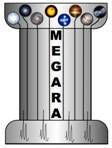Dept. Astrofísica y CC de la Atmósfera Univ. Complutense de Madrid
| Research lines:
Local star-forming galaxies Galaxy models Surveys Databases SHARDS project Stellar libraries Early-type galaxies Meteors and Fireballs Dark Skies |
Instrumental developments: MEGARA:Multi-Espectrógrafo en GTC de Alta Resolución para Astronomía |  |
| EMIR: Espectrógrafo Multiobjeto en el InfraRrojo |

| |
| FRIDA: inFrared Imager and Dissector for Adaptative optics |
 |
Asociaciones de estrellas jóvenes en el Anillo de Leo
 Un equipo internacional de investigadores, entre los que se encuentra Armando Gil de Paz, de la Universidad Complutense de Madrid, ha descubierto galaxias en proceso de formación en una nube de gas conocida como "el Anillo de Leo". Esta estructura está considerada como un objeto que ha permanecido prácticamente inalterado desde los primeros tiempos del Universo. Los resultados se publican hoy en la revista Nature.
Un equipo internacional de investigadores, entre los que se encuentra Armando Gil de Paz, de la Universidad Complutense de Madrid, ha descubierto galaxias en proceso de formación en una nube de gas conocida como "el Anillo de Leo". Esta estructura está considerada como un objeto que ha permanecido prácticamente inalterado desde los primeros tiempos del Universo. Los resultados se publican hoy en la revista Nature.
El satélite GALEX de la NASA ha detectado asociaciones de estrellas en la estructura conocida como el Leo Ring o Anillo de Leo, un objeto que hasta la fecha se pensaba que estaba constituida únicamente por gas (hidrógeno y helio). Las propiedades de estas estrellas, encontradas en imágenes ultravioleta tomadas por el satélite, indican una edad muy joven y un contenido muy bajo de elementos químicos más pesados que el hidrógeno y el helio.
En este descubrimiento ha participado un investigador del departamento de Astrofísica de la UCM, Armando Gil de Paz, junto a investigadores de las universidades norteamericanas de Columbia y Johns Hopking, el Laboratorio de Astrofísica de Marsella, los Observatorios Carnegie y el Instituto Tecnológico de California. El hallazgo se publica en el último número de Nature bajo el título "Massive star formation within the Leo primordial ring".
El Anillo de Leo se descubrió en los años 80 por la emisión del hidrógeno que lo compone mediante el uso de radiotelescopios desde tierra y durante los 25 años siguientes nunca se habían encontrado estrellas asociadas, a pesar de que se intentó repetidamente mediante imágenes profundas en el rango visible. Hasta el momento se pensaba que esta estructura estaba formada únicamente por gas y que había permanecido inalterada desde el Universo temprano.
II General Meeting of the ASTRID Project at the CAB
The II General Meeting of the ASTRID project was held last February 18th, at the Centro de Astrobiología (CAB), in Torrejón de Ardoz (Madrid). Thirty five scientists of seven different research institutions from Madrid attended to the meeting, as well as several agents from private partners associated to the ASTRID project. The goals of the meeting were to inform to the project members about all the activities developed in the project, and to identify and start new collaboration lines between the different research groups involved in the project.



The IScAI-2009 starts officially
After the successful pilot program in 2008, the IScAI will officially start in 2009. IScAI-2009 offers an intensive programme of courses and laboratory work in key areas related to the design and construction of scientific instrumentation. The laboratory work will be done at various research institutions and high-tech companies with world-class instrumentation programs in Europe and America.
IScAI-2009 is open to astronomers, physicists and engineers world-wide.
The web page can be found at http://www.iscai.iac.es/iscai/
Lens holder-structure for FRIDA


The images show the lens holder prototype for the FRIDA collimator, developed at CIDESI (Mexico). The whole structure is ready to be tested inside Colibrí, a cryostat specially designed for measuring the response of each one of the different FRIDA elements to cryogenic conditions.
IYA2009 Poster at UCM Physics
To illustrate the celebration of the International Year of Astronomy IYA2009, some members of UCM Dept. Astrophysics have displayed a big poster with some spectacular images.
More on this at IYA2009 at UCM.










